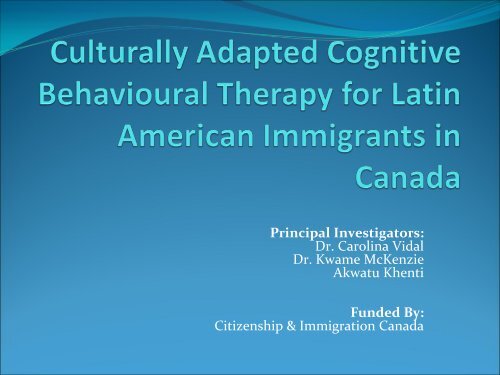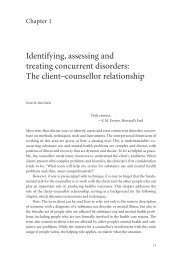Culturally Adapted Cognitive Behavioural Therapy for Latin ...
Culturally Adapted Cognitive Behavioural Therapy for Latin ...
Culturally Adapted Cognitive Behavioural Therapy for Latin ...
Create successful ePaper yourself
Turn your PDF publications into a flip-book with our unique Google optimized e-Paper software.
Referral sources <strong>for</strong> focus group participantsIglesia Hispana de WoodbridgeSan Lorenzo <strong>Latin</strong> American Community CentreReferral sources <strong>for</strong> therapy participantsBlack Creek Community Health CentreCOSTI Immigrant ServicesBelkis Fernández; pastor, Iglesia Hispana de Woodbridge, and executivedirector, Manantial Neighbourhood ServicesWomen’s Habitat of EtobicokeMennonite New Life Centre of TorontoTAPE Educational Services Inc.Organizations Hosting Focus GroupsCosti Immigrant Services (Family and Mental Health Services at SheridanMall)Manantial Neighbourhood ServicesSan Lorenzo <strong>Latin</strong> American Community Centre
learning objectives• to determine the need <strong>for</strong> the cultural adaptation ofCBT in <strong>Latin</strong> Americans in Canada• to describe the cultural adaptation process of CBT <strong>for</strong><strong>Latin</strong>os in Toronto
<strong>Latin</strong> Americans in Canada
LA in Canada• <strong>Latin</strong> Americans represent one of the fastest culturalgrowing groups; between 2001 and 2006, the numberreporting <strong>Latin</strong> American origins rose by 40.2% (59, 515),while the overall population grew by only 5.4%. (Census,2006)• most of the <strong>Latin</strong> American population belong to the firstgeneration and most are young (Statistics Canada, 2006)
<strong>Latin</strong> American Community in Canada is about 304,245 people,however, community organization and data re‐analysis show thatthe number may be between 500 and 700,000.it is one of the five major groups of visible minorities in Canadamost coming to Canada as refugee claimants.most of them are specifically located in the Toronto with 99,290people (Statistics Canada, 2006).the most common Origin Countries are El Salvador (18.6%),Colombia (15.1%) and Mexico (10.3%) (Canada’s EthnoculturalMosaic, 2006).
in the US most <strong>Latin</strong>os are Mexican‐Americansrepresenting 62% of the total <strong>Latin</strong>o population,followed by Puerto Ricans (12.7%); Cubans (5.3%);Central and South Americans (11.5%)(Organista, K. C & Munoz R. F.1996).
Prevalence of mental disordersFrom US and few Canadian studies LA presenthigher rates of lifetime prevalence of majordepression and post‐traumatic stress disordercompared to the general populationrisk factors are socioeconomic, acculturativestress and pre and post migration factorsbarriers and access to mental health services
Why the need <strong>for</strong> specialized mental healthservices <strong>for</strong> <strong>Latin</strong>os in Canada?• not only because of the population is large, isgrowing fast, is mostly young, most havecome to Canada as refugees and have riskfactors and higher rates of mental disorders• also because the Canadian context is quitedifferent from the US context
methods
Cultural adaptation process• Extensive literature review:psychotherapy research with minoritiesculturally adapted psychotherapies <strong>for</strong> LA inthe US
Cultural adaptation process culturally sensitive qualitative research methods deep understanding of recruitment and retention inpsychotherapy research and psychotherapytreatments with minorities and with LA cultural considerations in CBT <strong>for</strong> <strong>Latin</strong>os
why CBT and not otherpsychotherapies? CBT is considered first line treatment <strong>for</strong> cases ofmild to moderate depression in Canada according tothe Canadian Network <strong>for</strong> Mood and AnxietyTreatments (CANMAT) Clinical Guidelines <strong>for</strong> themanagement of major depressive disorder in adults(Kennedy S. H. Et al, 2009). CBT is considered as effective as medications.
CBT in <strong>Latin</strong>osonly few studies have been conducted on theeffectiveness of CBT <strong>for</strong> major depression in <strong>Latin</strong>opopulation
there have been five studies available since the 1980sand, out of those five, only two had samples that wereexclusively <strong>Latin</strong>o (Comas‐Diaz, 1981; Rosello & Bernal, 1999 inInterian et al., 2008).the remaining three included a significant proportionof <strong>Latin</strong>os (Miranda, Azocar et al., 2003; Miranda, Chung et al., 2003;Organista et al., 1994, in Interian et al., 2008).
according to these studies, CBT worked with thispopulation <strong>for</strong> major depression.however, symptom reduction level was lower thanthat seen with non <strong>Latin</strong>o samples, with a range ofpost treatment reduction of symptoms of 20% to64%..
also, there were significant differences in treatmentretention, which was only 62% <strong>for</strong> the <strong>Latin</strong>opopulation as compared to 95% <strong>for</strong> the non‐<strong>Latin</strong>opopulation testifying about the challenge of retainingpsychotherapy patients in treatment (Hollon et al., 1991 inInterian et al., 2008)
Organista (1996) describes that some of the CBTcomponents that account as to why it works with<strong>Latin</strong>os of low socio economic status and low levelsof acculturation is because traditional <strong>Latin</strong>os “prefershort‐term interventions, immediate symptom relief,guidance and advice and because CBT “demystify”psychotherapy. For instance, the use of homework,chalk boards like classroom experience, especially ingroup CBT it alleviates the stigma aboutpsychotherapy.
The need <strong>for</strong> cultural adaptation ofpsychotherapiesNagayama Hall (2001) argues that there is a need <strong>for</strong>empirically supported therapies (ESTs) that are alsoculturally‐sensitive (CST) therapies. CSTs “involvesthe tailoring of psychotherapy to specific culturalcontexts” stating that so far there is no evidence thatany EST is valid <strong>for</strong> ethnic minorities.
Almost all identified ESTs were <strong>Cognitive</strong>‐<strong>Behavioural</strong><strong>Therapy</strong> (CBT), Interpersonal Psychotherapy (IPT)and Psychodynamic Psychotherapy.
this assumes that all EST will work with anyoneincluding ethnic minorities and if this been the case,the question is: “if the ESTs were developed withNative Americans, |African Americans,<strong>Latin</strong>os/<strong>Latin</strong>as, or Asians, would researchers beadvocating <strong>for</strong> their use with the generalpopulation?”.
Cultural adaptation of CBTqualitative research methods are the ideal researchmethodologies <strong>for</strong> conducting psychotherapyresearch and <strong>for</strong> cultural adaptation ofpsychotherapies research.focus groups are use to obtain in‐depth in<strong>for</strong>mationabout what is it about the therapy that works (Bernal, G.,Bonilla, J.& Bellido, C. 1995; Brown C. & Lloyd, K., 2001; Interian, A., Allen, LA., Gara, M. & Escobar, JI. 2008;Interian, A. & Diaz‐Martinez, A. 2006;Interian, A., Martinez, I., Iglesias Rios, L., Krejci, J., Guarnaccia, PJ.Markowitz, J.C, et al 2009).
Key cultural considerations• interpersonal styles such as “simpatia”• common values such as “respeto”• language considerations in addition to Spanish, suchas phraseology.• Dichos (sayings)• Illness and symptom expression
Key cultural considerations• “familismo”• “<strong>for</strong>malismo”• “personalismo”• “fatalismo”
Mixed methods approach• Quantitative methodsliterature reviewCES‐D• Qualitative methodsFocus groups and key in<strong>for</strong>mant interviews
Stage one:• Extensive literature review of 30 years worth ofresearch in cultural adaptation of psychotherapies inthe US• Literature review on anticipated challenges inrecruiting and retaining participants• Exploration of all possible community agencies, ESLschools, churches, radio stations and leaders ingeneral of the <strong>Latin</strong> American community as possiblesources of participants
Stage two: Focus groups Men group Women group Young women group Indigenous people group Elderly group Community group Health professionals groupKey in<strong>for</strong>mant interviews Chilean female psychiatrist Salvadorean male psychiatrist
Stage three:• elaborating the first draft <strong>Culturally</strong>‐<strong>Adapted</strong><strong>Cognitive</strong> <strong>Behavioural</strong> <strong>Therapy</strong> (CA‐CBT)manual based on the literature review and focusgroups and key in<strong>for</strong>mant interviews
Stage four: recruiting 12 participants and three CBTbilingual and bicultural psychotherapists topilot test the draft CA‐CBT manual
Participant Selection Criteria• self‐identified <strong>Latin</strong> American Spanish or Englishspeakers• current residence in the GTA• current, mild to moderate symptoms of depression(e.g., CES‐D > 16 )• no current psychosis, mania, alcohol or substanceabuse, severe cognitive impairment, or acute risk ofsuicide• having a family doctor
Clinician Selection Criteria• fully bilingual English and Spanish• at least 5 years training or equivalent experience in a healthor allied profession• previous training and experience conducting CBT• strong understanding of the mental health needs and socialissues affecting the target populations.• willingness to be flexible in service provision (e.g., eveningor weekend hours).
Stage five:• participants focus groups to obtain their opinionabout the therapy• therapists focus groups to obtain feedback aboutthe delivery and the process of CA‐CBT and themanual.
Stage six:• final CA‐CBT manual based on previous stages• dissemination of the CA‐CBT manual to therapists inthe community.• knowledge translation strategies
esults• <strong>Culturally</strong> <strong>Adapted</strong> CBT manual <strong>for</strong> therapists<strong>for</strong> the treatment of mild to moderatedepression in people of <strong>Latin</strong> American origin inCanada
Recruitment and retention• faced the same challenges as US researchers• collected a purposeful sample• used culturally sensitive methods to recruitparticipants• were able to retain 80% of participants
How is it different from CBT?• culture‐based‐including key cultural considerations• addresses barriers and access that potential patientsmay encounter when seeking psychotherapytreatments in the community• canadian context‐based
conclusions<strong>Latin</strong> American people in Canada need specializedmental health services that are acceptable andfeasible in the communitythere is a need <strong>for</strong> the cultural adaptation whentreating culturally different patients, i.e. <strong>Latin</strong>American immigrants
ecommendations conducting effectiveness trials in Canada and the US<strong>for</strong> CA‐CBT <strong>for</strong> LA’s plus or minus case managementto deal with retention issues exploring the cultural adaptation of other EST suchas IPT exploring cultural adaptation of EST <strong>for</strong> otherimmigrant and or cultural groups in Canada
















